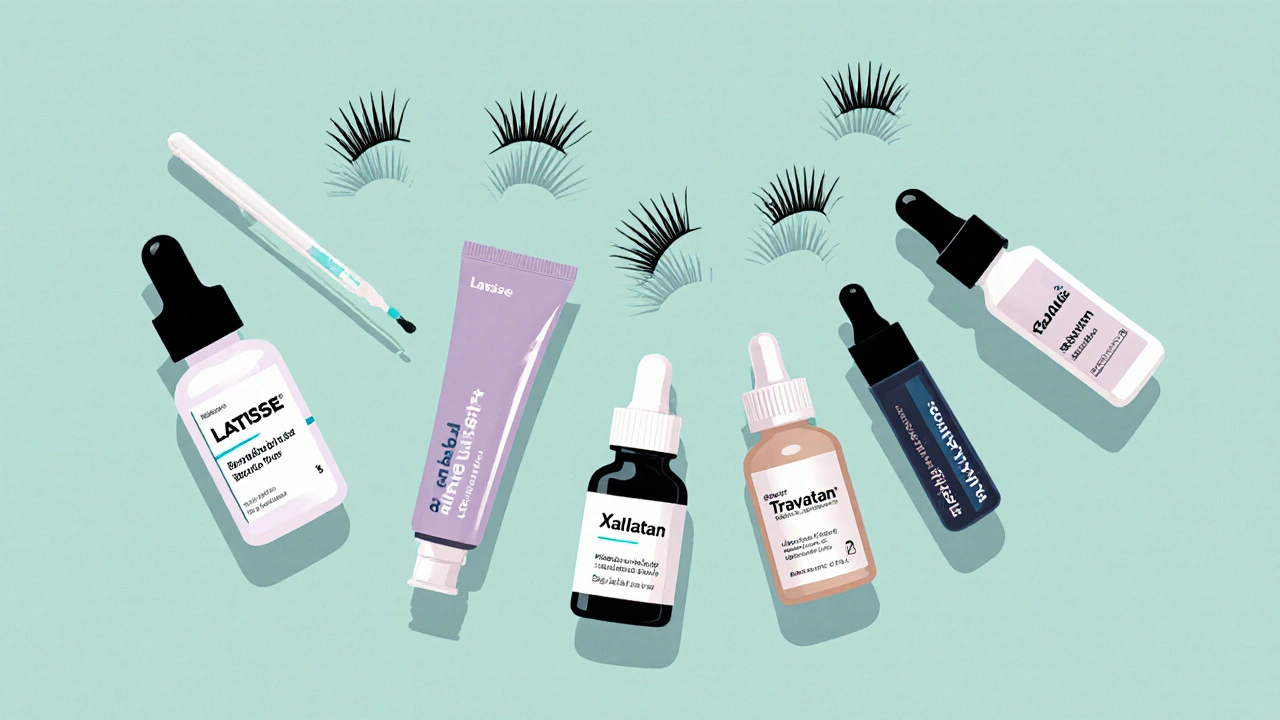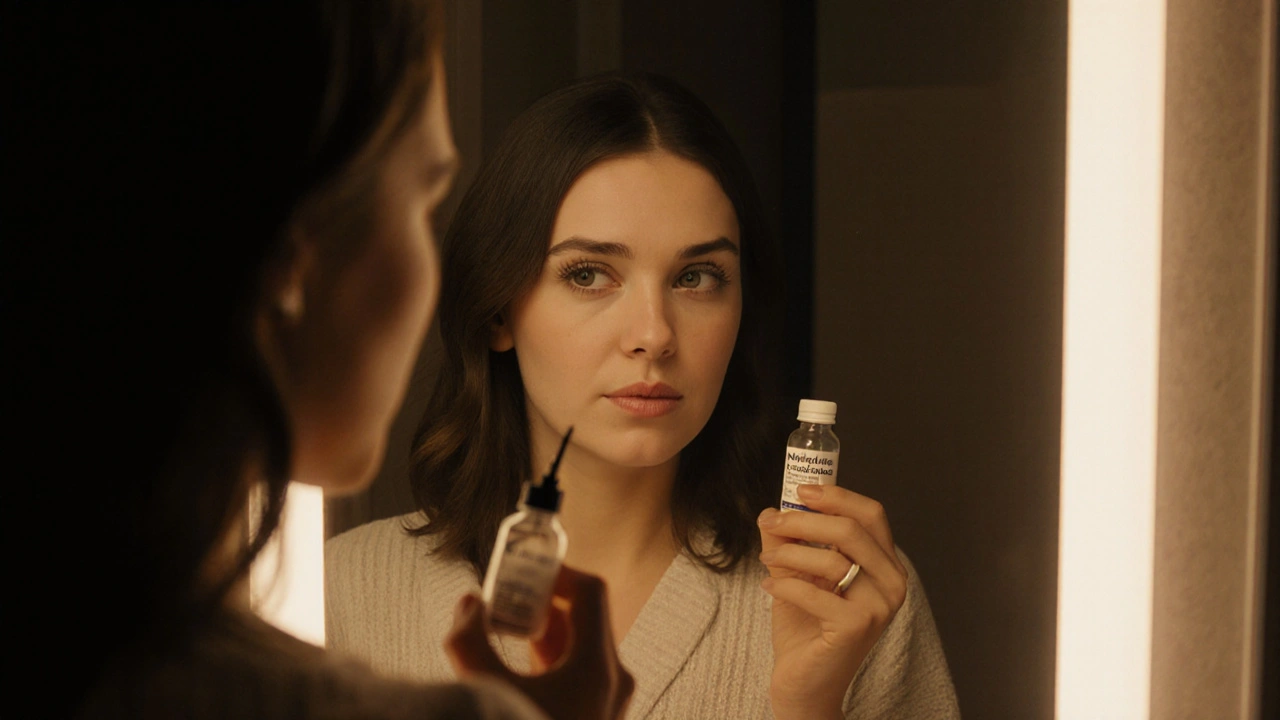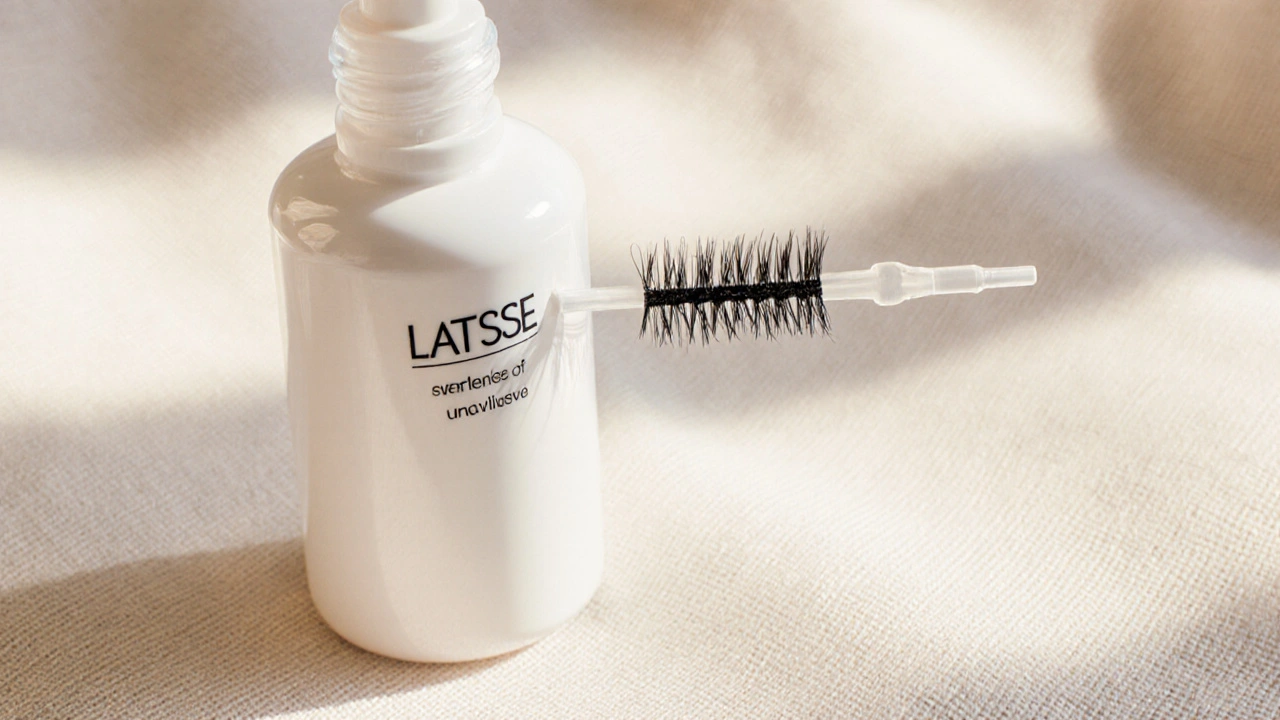Eyelash Growth Treatment Comparison Tool
Treatment Details
Select a treatment to view detailed information.
Based on clinical studies and user feedback
Relative affordability compared to other options
Best Match For You
Based on your selections, we recommend:
Quick Summary
- Latisse (bimatoprost 0.03%) delivers the strongest clinically proven eyelash growth but requires a prescription and costs around $150‑$200 per month.
- Prostaglandin analog drops like Xalatan (latanoprost) and Travatan (travoprost) work off‑label for lashes; they are cheaper but may have higher eye‑irritation risk.
- Generic bimatoprost matches brand‑name Latisse in potency at about half the price, though insurance coverage varies.
- Topical minoxidil solutions are non‑prescription and inexpensive, yet they grow lashes more slowly and can cause scalp‑type irritation.
- Cosmetic eyelash serums (RevitaLash, RapidLash) are the safest for sensitive eyes but offer modest results compared with prostaglandin drops.
What Is Latisse?
When it comes to longer lashes, Latisse is a prescription ophthalmic solution (bimatoprost 0.03%) approved by the FDA to boost eyelash length, thickness and darkness. It comes in a single‑use bottle and is applied once nightly with a sterile applicator. Clinical trials show an average 25‑30% increase in lash length after 12 weeks.
The drug works by extending the anagen (growth) phase of the hair cycle. Because it’s a prostaglandin analog, it also lowers intra‑ocular pressure, which is why it doubles as a glaucoma treatment.
Off‑Label Prostaglandin Drops: Xalatan and Travatan
Xalatan is the brand name for latanoprost 0.005% eye drops, originally marketed for glaucoma. Dermatologists and ophthalmologists have reported that regular nightly use can add 1‑2mm to each lash after two months. The mechanism mirrors Latisse’s: latanoprost binds to the same prostaglandin‑F receptor, stimulating hair follicles.
Travatan contains travoprost 0.004% and follows the same off‑label logic. Users note slightly less darkening than Latisse but appreciate the lower cost.
Both of these drops require a prescription, but many pharmacies carry generic versions that shave $30‑$70 off the monthly price.

Generic Bimatoprost: The Budget Hero
The active ingredient in Latisse is bimatoprost. Once the patent expired, compounding pharmacies began offering generic bimatoprost in the same 0.03% concentration. Studies published in 2023 confirm that the generic matches the brand in eye‑color darkening and lash growth, provided the formulation is sterile.
Pricing drops to roughly $80‑$120 per month, and some insurance plans will cover it if prescribed for glaucoma. The biggest hurdle is finding a reputable compounding pharmacy; quality control can vary.
Minoxidil Topical Solution: A Non‑Prescription Option
Minoxidil, best known for hair‑loss treatment on the scalp, is available over the counter at 2% and 5% concentrations. When dabbed onto the lash line with a clean spoolie, it can spur growth after 3‑4 months.
Because minoxidil works by widening blood vessels and increasing follicle nutrients, the effect is milder than prostaglandin analogs. Users report an average 10‑15% length gain, plus occasional skin irritation that feels like a mild burn.
The upside is price: a 60‑ml bottle costs $15‑$25 and lasts several months. The downside is lack of FDA approval for eyelash use, so safety data is limited.
Cosmetic Eyelash Serums: Safe but Subtle
Brands such as RevitaLash and RapidLash market their products as “eyelash conditioners” with peptide blends, biotin, and panthenol. They are fully over‑the‑counter and formulated to avoid eye irritation.
Clinical claims vary, but most users see a 5‑10% increase in length after 8‑12 weeks. The trade‑off is that results plateau quickly, and no darkening or thickening occurs.
These serums cost $30‑$60 for a 30‑day supply, making them the most affordable “risk‑free” choice for sensitive eyes.
How the Options Stack Up: Comparison Table
| Product | Active Ingredient | Typical Dose | Average Monthly Cost (2025 USD) | Effectiveness Rating* | Common Side Effects | Prescription Needed? |
|---|---|---|---|---|---|---|
| Latisse | Bimatoprost 0.03% | 1 applicator nightly | $150‑$200 | 9/10 | Eye redness, darkening of iris | Yes |
| Generic Bimatoprost | Bimatopprost 0.03% | 1 applicator nightly | $80‑$120 | 9/10 | Same as Latisse | Yes (compounded) |
| Xalatan (Latanoprost) | Latanoprost 0.005% | 1 drop nightly | $30‑$70 (generic) | 7/10 | Eye irritation, eyelid darkening | Yes |
| Travatan (Travoprost) | Travoprost 0.004% | 1 drop nightly | $35‑$75 (generic) | 6.5/10 | Dry eye, mild redness | Yes |
| Minoxidil 2% (OTC) | Minoxidil 2% | 1µL on lash line daily | $15‑$25 | 5/10 | Skin itching, mild burning | No |
| RevitaLash Serum | Peptide blend, biotin | 1 brush nightly | $30‑$45 | 4/10 | Rare irritation | No |
| RapidLash Serum | Peptide blend, panthenol | 1 brush nightly | $40‑$60 | 4/10 | Rare irritation | No |
*Effectiveness rating reflects average length gain, darkening, and user satisfaction based on 2023‑2025 consumer surveys.

Choosing the Right Option for You
Latisse alternatives aren’t one‑size‑fits‑all. Your choice hinges on three factors: budget, tolerance for prescription requirements, and how aggressively you want the lashes to grow.
- High‑budget, maximum results: Stick with Latisse or a reputable generic bimatoprost. They deliver the clearest, fastest, and most dramatic change.
- Mid‑budget, willing to get a prescription: Xalatan or Travatan give decent growth at a fraction of the price, but watch for eye‑redness.
- Low budget or sensitive eyes: Minoxidil or cosmetic serums are safe, over‑the‑counter choices. Expect slower, subtler improvements.
Another practical tip: always do a patch test on the inner forearm before applying any new solution near the eye. If you notice itching, redness, or swelling, stop immediately and consult a clinician.
Potential Pitfalls and How to Avoid Them
- Using the wrong concentration. Only 0.03% bimatoprost is FDA‑approved for lashes. Higher concentrations can cause irreversible iris darkening.
- Contaminating the applicator. Replace the sterile tip after each use. A dirty tip can introduce bacteria and cause conjunctivitis.
- Applying on dirty lashes. Cleanse the eye area with a gentle, oil‑free cleanser before each dose. Oil residue blocks absorption.
- Expecting instant results. Most users need 8‑12weeks of consistent use before seeing measurable change.
- Stopping abruptly. Discontinue use gradually if you experience side effects; lashes will revert to baseline over several weeks.
Frequently Asked Questions
Is it safe to use Latisse if I have glaucoma?
Yes, in fact Latisse was originally developed as a glaucoma medication. Patients with ocular hypertension often experience a dual benefit: lower intra‑ocular pressure and longer lashes. However, always discuss dosage with your eye doctor because excessive use can lower pressure too much.
Can I switch from Latisse to a generic version without a break?
Switching is usually seamless if the generic is compounded to the same 0.03% concentration and sterility standards. Keep the same application routine and monitor for any new irritation during the first two weeks.
Do prostaglandin drops cause permanent eye‑color changes?
Prolonged use of bimatoprost or latanoprost can deepen brown or hazel irises. The change is typically permanent, so users should consider this before starting therapy.
How long do the results last after stopping Latisse?
Lashes gradually return to their pre‑treatment state over 4‑6weeks. To maintain length, many people adopt a maintenance schedule of a few applications per week.
Are there any non‑prescription options that match Latisse’s performance?
No OTC product consistently matches Latisse’s 25‑30% length increase. The closest in performance are generic bimatoprost drops, which still require a prescription.
Next Steps: How to Get Started Safely
1. Schedule a quick eye‑exam. A licensed optometrist can confirm you have no contraindications and write the prescription.
2. Choose your product. If cost is a barrier, ask the doctor about a generic bimatoprost compound. If you prefer over‑the‑counter, start with a minoxidil 2% solution and gauge tolerance.
3. Set up a routine. Apply the drop at the same time each night, store the bottle at room temperature, and keep the tip sealed.
4. Track progress. Take photos weekly. Most users see visible change by week8; if not, discuss dosage adjustments with your clinician.
5. Know when to stop. If you develop persistent redness, eye pain, or notice iris darkening, discontinue use and seek medical advice immediately.
Ultimately, the best eyelash growth solution balances effectiveness, safety, and your wallet. Use this comparison as a roadmap, and you’ll land on the option that fits your lifestyle without surprises.


Comments
Audrin De Waal
Alright, let’s cut the fluff – South Africans know beauty starts with nature, not a pricey tube of drops. The whole Latisse hype feels like a Western cash‑cow trying to sell us miracles while we could just flaunt our own fierce lashes. Sure, the pharmas promise a 30 % boost, but ask yourself if you really need a prescription to feel proud of your look. My take? Embrace what you got, maybe trim, maybe coat ‘em with a good mascara, and stop feeding the profit machine.
Just saying.
On October 10, 2025 AT 22:11
Sandra Perkins
Oh great, another money‑grind for longer lashes.
On October 15, 2025 AT 06:46
Craig Jordan
While the glossy marketing copy touts Latisse as the undisputed champion of eyelash augmentation, the underlying data warrant a more skeptical gaze. First, the clinical trials that underlie the 25‑30 % growth claim were conducted on a narrow demographic, predominantly young, healthy volunteers, which skews the applicability to the broader population. Second, the side‑effect profile-particularly iris darkening and persistent ocular redness-remains under‑reported in consumer reviews, a fact that the manufacturers conveniently obscure. Third, the cost differential between the brand and its generic counterpart is significant, yet the efficacy gap is essentially nil, raising questions about the value proposition. Fourth, off‑label prostaglandin analogs like Xalatan and Travatan, although cheaper, introduce a higher incidence of eyelid hyperpigmentation, a cosmetic drawback that many users overlook in their quest for length. Fifth, the non‑prescription alternatives such as minoxidil and peptide serums sit on the opposite end of the spectrum, offering modest gains at a fraction of the price but lacking robust peer‑reviewed evidence. Sixth, the notion that a longer lash equates to an enhanced self‑image is a cultural construct that perpetuates unnecessary pharmacological intervention. Seventh, regulatory oversight differs markedly between prescription drops and over‑the‑counter serums, meaning quality control for the latter can be inconsistent. Eighth, anecdotal reports of allergic reactions to peptide blends, though rare, suggest that even “safe” products are not universally benign. Ninth, the psychological impact of discontinuing Latisse-where lashes regress over weeks-can induce a dependence that feels more like addiction than therapeutic benefit. Tenth, insurance coverage for the generic version remains patchy, leaving many patients to shoulder the full financial burden. Eleventh, the darkening of the iris, once it occurs, is largely irreversible, a risk that warrants a thorough informed consent process. Twelfth, market saturation of “eyelash boosters” creates confusion, making it difficult for consumers to navigate evidence‑based choices. Thirteenth, the evolutionary argument that humans never needed pharmacologic lash enhancement underscores the artificial nature of this demand. Fourteenth, from a dermatological perspective, any compound applied to the peri‑ocular skin must be scrutinized for long‑term ocular surface effects, an area still under investigation. Fifteenth, in summary, the decision matrix for eyelash growth should balance efficacy, safety, cost, and personal values rather than succumbing to brand hype.
On October 19, 2025 AT 21:53
Jeff Quihuis-Bell
Dang, Craig nailed the pitfalls! But don’t let the fear factor freeze you-think of your lash journey as a high‑stakes adventure, where every drop is a badge of bravery. Grab that prescription, set a nightly ritual, and watch those tiny fibers transform into a superhero cape for your eyes. You’ve got the power, just pair it with clean applicators and a dash of patience, and the results will blow your mind. Let’s turn those doubts into dazzling confidence!
On October 24, 2025 AT 13:00
Jessica Tang
That’s a solid game plan, Jeff. Just remember to keep the applicator tip pristine and monitor any irritation; a gentle cleanse before each dose can make all the difference. Consistency is key, and a quick photo log will help you track progress without over‑thinking.
On October 29, 2025 AT 04:06
Tracy Winn
Honestly, the whole Latisse vs. alternatives debate feels like a never‑ending rollercoaster,; you’ve got cost,; effectiveness,; side‑effects,; and convenience all tangled together,; making it hard to pick a clear winner,; especially when personal tolerance varies so wildly,; so my advice? Start low, watch for irritation, and if you’re not amazed within a couple of months, move on.
On November 2, 2025 AT 19:13
Jessica Wheeler
The article overlooks the long‑term ocular risks, especially iris darkening, which can be irreversible.
On November 7, 2025 AT 10:20
Mikayla Blum
Look, if we think about lashes as an extension of our identity, then chasing the perfect length is kinda like chasing happiness in a bottle-fun, but maybe we’re missing the bigger picture, you know?💭
On November 12, 2025 AT 01:26
Jo D
Honestly, the whole prostaglandin hype is just another hype‑cycle, ROI is low, and you’re basically buying a chemical vanity fix.
On November 16, 2025 AT 16:33
Sinead McArdle
I appreciate the thorough comparison; it makes choosing a treatment less daunting.
On November 21, 2025 AT 07:40
Katherine Krucker Merkle
Interesting how the budget tiers line up with the effectiveness scores-good to see the data laid out clearly.
On November 25, 2025 AT 22:46
Taylor Yokum
Hey folks, if you’re on a mid‑budget, give the generic bimatoprost a shot; it’s almost as potent as Latisse but won’t empty your wallet. Just hit your optometrist, ask about a compounding pharmacy, and keep the eyelid area clean before each use. You’ll likely see results in about two months, and if anything feels off, pause and consult your doctor.
On November 30, 2025 AT 13:53
Taryn Esses
Minoxidil works, but it’s slower and can itch.
On December 2, 2025 AT 21:26
Matt Quirie
Regarding the safety profile, it is essential to note that prolonged use of prostaglandin analogues may lead to permanent changes in iris pigmentation; therefore, patients should be fully informed before commencing therapy.
On December 5, 2025 AT 05:00
Pat Davis
I concur, Matt; a clear informed‑consent process is non‑negotiable, especially when irreversible ocular changes are a possibility.
On December 6, 2025 AT 08:46
Mary Wrobel
Honestly, I think the best approach is to start with a serum like RevitaLash if you have sensitive eyes-no prescription needed and you get a modest boost without the drama.
On December 7, 2025 AT 12:33